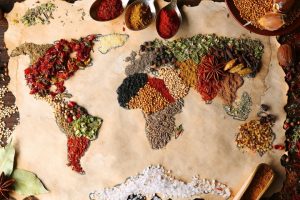Preserving food traditions is important because it connects us to our cultural history, preserves our culinary diversity, and helps us learn more about foods from around the world. However, this work also brings with it challenges and opportunities. It is important to understand these forces to ensure that food traditions are not only preserved but also respected and transformed for future generations.
The Importance of Preserving Food Traditions
Food traditions are an important part of national identity and hold communities together. By passing down cooking techniques and recipes from generation to generation, they create a sense of consistency. Traditional dishes often contain important historical, social, and cultural stories that help us understand a society’s heritage. Some of these customs include specific cooking methods, ingredients unique to the region, and ritualistic ways of preparing and eating food.
Preserving these customs helps keep different cultures alive and encourages respect for different ways of life. It also allows future generations to enjoy and learn about a variety of foods from around the world. As modernization and globalization continue to change the world, it is more important than ever to maintain food traditions to preserve national identity and diversity.
Challenges in Preserving Food Traditions
1. Modernization and Globalization
The impact of modernization and globalization is one of the biggest challenges to maintaining food habits. As society changes, global food trends and fast-paced lifestyles can make old ways of doing things less relevant. People often eat less traditional foods because there are many foreign fast food chains and convenience foods. Younger generations may become more accustomed to global foods, which could mean that local recipes and cooking styles will disappear.
2. Loss of Past Expertise
Food traditions are often passed down directly from one generation to the next. As people cook less at home and family structures change, voice communication can be compromised. As the people who have passed down these recipes, techniques, and eating rituals for generations age and die, there is growing concern that important information about them is being lost.
3. Economic Pressures
Maintaining dietary habits is also difficult because of the economic impact. In many parts of the world, people prefer cheap, simple foods over traditional cooking because money is tight. Traditional meals can be difficult to make for people on a budget because they require a lot of time, money, and ingredients. In addition, global food markets tend to emphasize mass production and standardization, which can make it harder for traditional farming methods to survive and for local ingredients to be sourced.
4. Changing Dietary Preferences
As people’s tastes in food change, they may find traditional foods less useful or appealing. Healthy eating, vegetarianism, and veganism are becoming more popular. This can lead people to eat fewer classic meat-based dishes or dishes with ingredients that are no longer popular. This change in what people want to eat makes it difficult to maintain traditional recipes that do not fit in with modern health trends.
5. Loss of Culture
Sometimes, globalization and cultural exchange weaken traditional food habits. When different types of food are mixed, they can create interesting new meals, but they can also overshadow or replace old recipes. As traditional foods become more popular, they can lose some of their originality as recipes change to meet different tastes and market demands.
Opportunities for Preserving Food Traditions
Culinary heritage projects: A great way to keep food habits alive is through culinary heritage projects. As part of these projects, traditional recipes, cooking methods, and eating habits are recorded so that they can be passed on to future generations.
Food festivals and cultural events: Food festivals and cultural events are a way to celebrate and showcase traditional cooking methods. People from different regions can come together at these events to share their food history and support traditional dishes.
Participate in the community: Community participation is key to keeping food practices alive. With the help of local businesses, community groups, and cultural institutions, traditional food practices can be promoted and sustained.
Food tourism: Attracting tourists who want to try authentic local cuisine is one-way food tourism can help improve and maintain local food practices.
Technology and digital media: Technology and digital media can help keep food practices alive and spread them to new people. Online tools such as social media, blogs, and recipe websites make it possible to capture and share traditional cooking methods and recipes.
Conclusion
Keeping food traditions alive is hard work, but it pays off in the end. You have to deal with challenges and seize opportunities. Modernization, economic pressures, and changing food preferences are all major challenges, but there are also many opportunities to protect and promote traditional food practices. By developing projects that preserve our culinary heritage, supporting local farmers, and using technology, we can ensure that a wide variety of global cuisines are preserved for future generations. Finally, preserving food traditions contributes to our cultural heritage and helps us understand how food connects us to the past, present, and future.
FAQs
1. Why is it important to preserve food habits?
Preserving food habits is important because they represent cultural heritage, historical stories, and shared values. Food traditions help preserve national identity and diversity and connect generations. They also provide a way for people to respect and enjoy the unique food traditions and recipes of different groups.
2. How does technology change the way people eat?
Modernization can change eating habits by introducing global food trends, which diminishes the importance of local habits. People often lose interest in their previous way of cooking and eating due to fast food and convenience foods. Modernization can also change existing ingredients and the way food is cooked, making it harder for traditional recipes to survive.
3. How does food tourism help keep food habits alive?
Food tourism can help keep traditional eating habits alive by attracting tourists who want to try authentic local cuisine. By integrating traditional dishes and cooking methods into tourist activities, places can support local chefs and food producers while drawing attention to the cultural importance of these foods.
4. What can everyone do to keep food habits alive?
People can help keep food traditions alive by learning and using traditional cooking methods, attending cultural gastronomic events, and buying food from local farmers. To keep these traditions alive, people can share recipes and stories with family and friends, start projects that preserve culinary history, and teach others about the importance of traditional foods.
5. What can communities do to maintain food practices?
Communities can help preserve traditional foods by organizing food festivals, cultural events, and educational programs dedicated to them. Cultural and community groups in the area can help record and share culinary heritage. Food traditions can be kept alive by involving people in the community in activities that benefit the environment and by supporting local farmers and food suppliers.




